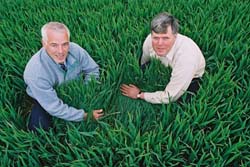
L. E. Carr & Sons' continuing success in the NFU Essex Farms Competition (previously county winners, the farm was in the top three again last year) is testament to the way the Carr brothers, Edward and Richard, manage the 592ha family farm at Latchingdon, near Maldon. With weeds such as Black-grass and diseases such as Brown Rust being particular problems for winter wheat, keeping crops looking good for the on-farm inspection in June, and yielding well at harvest, is far from easy.
The farm is on heavy London clay, bordering the Blackwater Estuary, 10 miles from the sea. Annual rainfall is low, at 500mm – but the air can often be damp with coastal mist.
Problems with Black-grass and the disease Take-all mean the farm is most suited to growing first wheats. Current break crops include oil seed rape, linseed, and peas for either human consumption or dry pet food. Edward and Richard also grow naked oats on contract, and 112ha of lucerne for local horse feed company Dengie. Grown for three years, the lucerne helps clear the fields of persistent cereal weeds and builds soil fertility for the following wheat crop. There is also 6ha of two old wheat varieties, Maris Huntsman and Maris Widgeon, to supply straw to two local thatchers.
Consort and Claire are the two main commercial wheat varieties currently sown, in a 50:50 split on 220ha. Yields averaged an all time high at 9.3t/ha last year, with some fields doing up to 10t/ha. The grain is marketed through Nidera (previously Unwin Grain) based at Ipswich, and exported.
In the autumn the fields going into wheat are ploughed and spread with poultry manure. They are then cultivated before drilling at the end of September/early October. Seed rates are at the high end at 320 seeds for each square metre, to compensate for any less-than-perfect seedbeds or significant slug damage.
A herbicide application in November targets Black-grass and broadleaved weeds. From then on fields are managed individually – depending on previous cropping and the variety grown. For example, wheat grown after oats has more additional liquid nitrogen fertiliser applied in the spring than wheat sown after lucerne.
When it comes to disease control the Consort and Claire have spray programmes tailored to their specific disease strengths/weaknesses. With a disease rating of 4 for Brown Rust, Consort needs much greater protection than Claire which scores 8, and this is reflected in Richard's disease control strategy.
At the T0 spray timing this year the Consort was treated with Opus (epoxiconazole) and chlorothalonil for early Septoria control. At T1 Richard applied BASF strobilurin fungicide Comet (pyraclostrobin) – which he used for the first time last year – in a mix with Opus and chlorothalonil, to get on top of the Brown Rust.
"In previous years our Brown Rust control has been a bit of a fire engine job – usually applying a morpholine spray at flag leaf stage. This may have held the problem in check for a while but it wasn't getting rid of it," explains Richard.
"We noticed a real difference when we used Comet last year; there was significantly less disease in the crop – yet on untreated headlands next to ditches it still ran riot.
"It looks like the T1 spray is holding it at bay again this year. We can't see Brown Rust pustules on the leaves like we used to, and we will be applying more Comet at T2 if necessary."
Richard's technical agronomist Martin Foster from UAP has worked in the area for 15 years and agrees that the Comet is working well for farmers across Essex.
"It is much better to plan your entire disease control programme, rather than leaving some of it to the last minute – especially on varieties you know are susceptible to diseases present on your farm," he says.
"Going in late with a morpholine to counter Brown Rust can cause leaf tipping if the weather is hot. Using Comet at T1 and T2 will give lasting control, and be much kinder to the crop. And the extra operational costs of going in for a late spray should not be underestimated."
